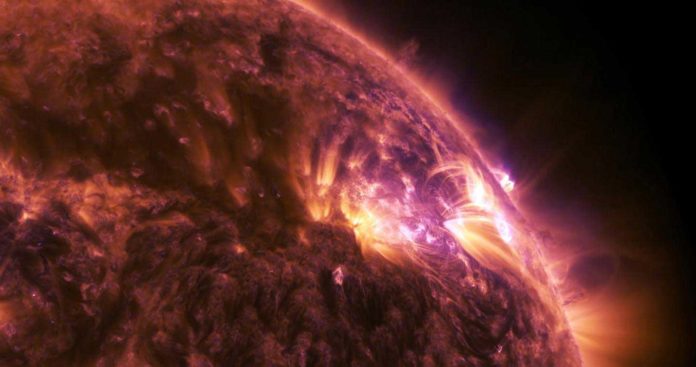The Sun is the most powerful particle accelerator in the solar system, able to accelerate ions and electrons well into the energy range of galactic cosmic rays. It is the most powerful particle accelerator in the solar system able to accelerate ions up to tens of GeV and electrons up to hundreds of MeV.
Shock waves generated by intense solar flares may be driven by a large amount of ejected mass and the total energy involved. Additionally driving high-energy waves is the solar wind – plasma that constantly flows out of the sun and buffets the Earth’s protective magnetic field.
Scientists at the U.S. Department of Energy’s (DOE) Princeton Plasma Physics Laboratory (PPPL) in the Princeton Center for Heliophysics have for the first time reproduced the process behind the source of such astrophysical shocks. Their experiments demonstrated that the interaction of plasma may lead to jumps in plasma pressure and magnetic field strength that can accelerate particles to near the speed of light.
Such shocks are “collisionless” as they are formed by the interaction of waves and plasma particles as opposed to by crashes between the particles themselves.
The research, conducted on the Omega laser facility at the University of Rochester, produced a laser-driven plasma — called a “piston” plasma — that expanded at the supersonic rate of more than one million miles per hour through a pre-existing ambient plasma. The expansion accelerated ions in the ambient plasma to speeds of roughly half-a-million miles per hour, simulating the forerunner to collisionless shocks that occur throughout the cosmos.
Physicist Derek Schaeffer of PPPL and Princeton University, who led the research said, “Direct measurement is an elegant way to see how the particles are moving and interacting. Our paper shows that we can employ a powerful diagnostic to study the particle motions that lead to shocks.”
The research unfolded in several stages:
- First, the creation of the piston plasma reproduced the supersonic plasmas that form in outer space. The piston acted like a snowplow, sweeping up ions in the ambient plasma embedded in a magnetic field.
- As more of these ions became swept up, they formed a barrier that kept the piston from acting further. “Once you’ve piled up enough ‘snow’, the shock decouples from the piston,” Schaeffer said.
- The halted piston handed off the formation of the shock to the highly compressed magnetized plasma, which gave rise to the sudden collisionless jump.
Scientists tracked these developments using a diagnostic called Thompson. The diagnostic recognizes laser light scattered off the electrons in the plasma, empowering estimation of the temperature and density of the electrons and the speed of the streaming ions.
Scientists noted that the laboratory experiments can probe the behavior of plasma particles in the precursor to collisionless astrophysical shocks, “and can complement, and in some cases overcome the limitations of similar measurements undertaken by spacecraft missions.
The details are reported in Physical Review Letters.
